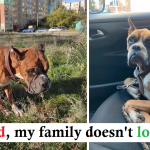They arrived to research after receiving a name a few mom dog and her puppies who have been misplaced within the woods. However after we received there, we observed a dismal scene.
The puppies have been ravenous and hiding in adjoining thorns after the mom dog had died a number of days earlier than.
Thanks and God’s blessings for rescuing these cute puppies.
I recognize you performing the Lord’s work! Could she relaxation in peace and that planet be crammed with love and caring for the puppies.
Oh my, these puppies are so cute. I am positive many will wish to undertake them, and it is horrible that the mom did not make it out alive.
I recognize you rescuing them.
Mom dog is poor. Rip! Lastly, your puppies appear to be in great arms and have bubbly tummies.
Introducing a dog to a cat can be a delicate process, but with patience and careful management, they can learn to coexist peacefully. Here are some tips for introducing a dog to a cat:
- Start Slowly: Allow the cat and dog to become familiar with each other’s scent before they meet face-to-face. Swap bedding or toys between them so they can get used to each other’s smell.
- Controlled Introduction: Keep the initial meetings controlled and supervised. Use a leash on the dog and keep the cat in a carrier or another safe, elevated space where it can observe the dog from a distance.
- Positive Reinforcement: Reward both the dog and the cat for calm, non-aggressive behavior during their interactions. Treats, praise, and affection can help reinforce positive associations.
- Respect Boundaries: Teach the dog to respect the cat’s space and boundaries. Discourage any chasing or rough behavior towards the cat.
- Provide Escape Routes: Ensure the cat has plenty of escape routes and high places to retreat to if it feels threatened. This could include cat trees, shelves, or furniture where the dog cannot reach.
- Supervised Interaction: Always supervise interactions between the dog and cat, especially in the early stages of their relationship. Be ready to intervene if necessary to prevent any conflicts.
- Regular Brushing: Brushing your dog’s hair is crucial for removing loose fur, dirt, and debris, which can lead to mats and tangles if left unattended. The frequency of brushing depends on your dog’s coat type. Dogs with long hair, such as Golden Retrievers or Afghan Hounds, may require daily brushing to prevent matting. On the other hand, short-haired breeds like Beagles or Boxers may only need brushing a few times a week. Use a brush appropriate for your dog’s coat type, such as a slicker brush for long-haired breeds or a rubber curry brush for short-haired breeds.
- Training: Train your dog to obey commands such as “leave it” or “stay” to help control its behavior around the cat. Positive reinforcement training methods work best.
- Patience: Building a positive relationship between a dog and a cat takes time and patience. Don’t rush the process and be prepared for setbacks along the way.
- Separate Spaces: Initially, keep the dog and cat in separate areas of the house when you’re not able to supervise them. This prevents any potential conflicts when you’re not around.
- Consult a Professional: If you’re having difficulty introducing your dog to your cat, consider seeking advice from a professional animal behaviorist or trainer who can provide personalized guidance based on your specific situation.
By following these tips and being patient, you can help your dog and cat learn to coexist peacefully and even become friends over time.








